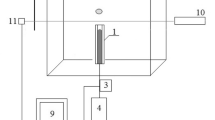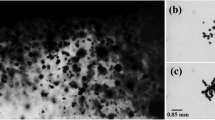Abstract
SOME years ago, one of us (K. S. I.), working in the laboratory of the late Prof. E. G. Richardson (King's College, Newcastle upon Tyne), made use of sound reverberation and optical scattering methods1 in an attempt to detect the presence and determine the size-distribution of nuclei responsible for the low tensile strength of liquids. During the course of the experiments it became evident that the nuclei existed in two forms in water—as stable air bubbles and as solid suspensions. The bubble nuclei, apart from possessing other unique features, were characterized by measurements of a consistent and reproducible nature when water containing them was subjected to ultrasonic and hydrostatic pressures. The measurements associated with the solid nuclei were erratic and showed considerable scatter.
This is a preview of subscription content, access via your institution
Access options
Subscribe to this journal
Receive 51 print issues and online access
$199.00 per year
only $3.90 per issue
Buy this article
- Purchase on Springer Link
- Instant access to full article PDF
Prices may be subject to local taxes which are calculated during checkout
Similar content being viewed by others
References
Iyengar, K. S., and Richardson, E. G., Brit. J. App. Phys., 9, 154 (1958); Mech. Eng. Res. Lab., D.S.I.R., Fluid Note, Nos. 42 and 55.
Turner, W. R., J. Acoust. Soc. Amer., 32, 928 (1960).
Connolly, W., and Fox, F. E., J. Acoust. Soc. Amer., 26, 843 (1954).
Author information
Authors and Affiliations
Rights and permissions
About this article
Cite this article
HASAN, M., IYENGAR, K. Size and Growth of Cavitation Bubble Nuclei. Nature 199, 995–996 (1963). https://doi.org/10.1038/199995a0
Issue Date:
DOI: https://doi.org/10.1038/199995a0
Comments
By submitting a comment you agree to abide by our Terms and Community Guidelines. If you find something abusive or that does not comply with our terms or guidelines please flag it as inappropriate.



